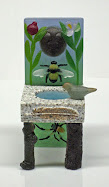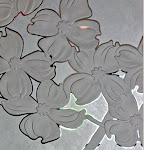One of my
readers commented that he didn't understand the process of my work
and although I have a very detailed explanation on my website, I
thought I would describe it here.
Pate de verre,
literally translated means 'paste of glass', is just one of several
kiln casting techniques. I say kiln casting because the work we do
is formed in a kiln and not with molten glass out of a furnace or
formed on the end of a blow pipe.
The process as
we developed it is a lost wax process similar to bronze and precious
metal casting, like jewelry. Other artists use clay for their models
and some cast from life, burning out the organic material in the kiln
before adding the glass to the mold. Our models are sculpted in wax.
A model is an exact replica of the thing you wish to cast in glass.
Pate de verre is
one of the oldest known forms of glass forming, going back 3,500
years or so. The name for this technique comes from a revival by
french artists in the late 19th century. If you are
interested in a more detailed history of glass forming in general and
pate de verre in particular, you can read about it here.
The first step
to any piece is to make the model. Sometimes I carve the item out of
a block of wax (like the peach inlay piece), sometimes I build it up
with shapes cut out of wax made into 1/8” thick 'sheets' and fill
in the hollow areas with small bits of wax (like the flower
sculpture), and sometimes I use reproduction molds that I have made
from an object (like the latex mold of the peach pit) that I pour
melted wax into. For the box itself, we made thick slabs of wax to
specific dimensions and I joined them together.
wax carving in
progress
Once the model
is finished, it is glued down to a surface to keep it from floating
up when the investment, or mold material, is poured over it. When
the glue has dried, we make a dam, or coddle, around the model
leaving an inch or two of space between the model and the sides of
the coddle.
set up for
investment
Our investment,
or mold material, is composed of plaster powder and silica flour and
water. When mixed, it is poured into the space between the model and
the coddle until it has covered the model completely to a thickness
equal to that of the space around the model. When the investment has
hardened, then the wax is melted out, hence the term 'lost wax',
leaving a negative space in the now hard investment material. This
is the casting mold.
pouring
investment around the model
finished mold
The next step is
to add the glass into the mold. Our technique, pate de verre, uses
glass that is crushed to the consistency of sand, called 'frit' or
powder. I mix the frit and powder with a binding agent or glue to
make a 'paste' of the glass and pack the different colored glass
pastes into the negative spaces of the mold where I want the colors
to be in the fired piece. This process can be very tedious and take
many hours.
placing the
glass 'paste' in the mold
Once all the
necessary glass is in the mold, it goes in the kiln for a 3 – 5 day
firing. It must be heated up slowly, held at casting temperature for
a specific amount of time, and then cooled down very slowly. Going
too fast up or down results in either a cracked mold or a cracked
piece. We have no control, really, once it is in the kiln, beyond
programming the firing schedule.
After the firing
schedule is completed and the inside of the kiln has returned to the
ambient temperature, the mold is removed from the kiln. After firing
the previously strong plaster/silica mold is now very soft and easily
breaks away from the cast glass inside.
removing the
investment material
After the
plaster/silica residue has been removed from the surface of the
piece, the final finish work is done with small diamond bits and
polishing compounds. Some pieces need a lot of finish work and some
hardly need any at all.
doing the finish
work
We never know
until it comes out of the kiln if everything went as planned. When
we first started out we had a failure rate that exceeded 50%. Now,
it's about 10%.
This process is
probably the most tedious, time consuming, detail oriented, and
frustrating thing I have ever done but it is also one of the most
rewarding when it all comes together and comes out right. It's also
the only process that allows for specific placement of color in the
mold and the finished piece and the only process that gives the
finished work it's distinctive luster when using transparent glasses.
a finished piece

















thanks for walking us through this! it is fascinating for those of us not familiar with any of it.
ReplyDeleteand WOW! talk about a TIME investment in your work!
I sort of knew how the process went, but this was really fascinating. I can't even imagine having the patience for that type of work.
ReplyDeleteEllen, this is spectacular. I never knew of such a glass process. I love glass works. They always capture me. I have a couple of Satavas. Brightened my day. Thanks.
ReplyDeleteWhat a process. You do such skilled, beautiful work. I'm always so impressed.
ReplyDeleteInteresting! I'm glad to see how all this works. I guess I had some vague idea what you were doing, but definitely not the step-by-step process.
ReplyDeleteYour comments about never knowing how something will turn out remind me of my days doing pottery. Same thing -- you put it in the kiln, and it's out of your hands!
I think glass is one of the most beautiful materials
ReplyDeletethe look, feel of it is wonderful
I love your work
Thanks for your step bye step! Your work is so beautiful & the finished pieces are amazing. I'm working on a series of eyes but I'm at about the 50% success/failure rate. My molds almost always crack. Thank you for sharing!
ReplyDeleteThank you very much Ms.Ellen.
ReplyDeleteSuch an intricate process. I understand a bit better. We use a "molding" process with our caststone,,,but,,,the beauty in your finished products is exceptional...thanks, glenn
Glass is so fascinating. A beautiful medium to work with, and it must be like magic when the piece finally emerges. Magic at least 90% of the time.
ReplyDeleteElaborate and enthralling... what do you do with the wax after you are done?
ReplyDelete